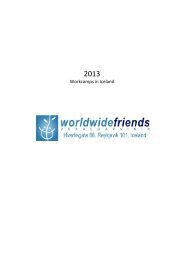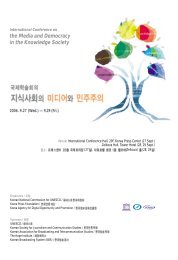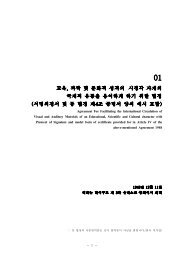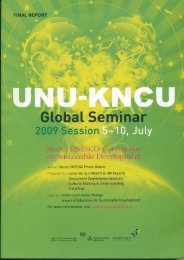íëìë³´ë2012문íì ë°ì ë¼ì´ëí ì´ë¸.pdf - ì ë¤ì¤ì½íêµììí
íëìë³´ë2012문íì ë°ì ë¼ì´ëí ì´ë¸.pdf - ì ë¤ì¤ì½íêµììí
íëìë³´ë2012문íì ë°ì ë¼ì´ëí ì´ë¸.pdf - ì ë¤ì¤ì½íêµììí
You also want an ePaper? Increase the reach of your titles
YUMPU automatically turns print PDFs into web optimized ePapers that Google loves.
Third, despite the overwhelming support of the member states for the Cultural Diversity<br />
Convention at the UNESCO General Assembly in 2005, developed countries and a vast<br />
majority of donor states have expressed their dissatisfaction with the Convention. In<br />
particular, the United States, which aggressively promotes the export of its massive cultural<br />
capital, is opposed to the screen quota and other such methods countries use to protect their<br />
domestic cultural industries.<br />
Furthermore, the West has a tendency to confront non-aligned nations (the so-called “G-77”<br />
that hold anti-American and anti-Western stances in the international arena. Unlike<br />
diplomatic rhetoric, the discourse on “cultural diversity” has had little impact in actual<br />
international development cooperation. In a world divided into the “mainstream” cultures and<br />
the “fringe,” or the powerful nations and the weak, the mainstream or powerful countries tend<br />
to be uncomfortable with the notion of cultural diversity.<br />
As explained above, culture has an institutional limit in establishing itself as an<br />
independent sector of development. Nonetheless, culture has been commercialized in both its<br />
tangible and intangible forms, and as indicated in the aforementioned classification by<br />
Throsby, already serves a function as a sector of development whose economic value or CID<br />
can be identified. In fact, while culture is not a sector in the grand classification per se, it is<br />
often dealt as a subcategory under themes such as environment or sustainable development 7 .<br />
Culture has the potential to be established as a sector in the future if it can change public<br />
perception and increase awareness, and reach a consensus among participants. In this sense,<br />
any debate as to whether culture constitutes a sector of development at this current time is<br />
pointless and unproductive, as it may only be a matter of time and perception. A more<br />
realistic choice of action in the discourse on culture and development would be to recognize<br />
that culture is an integral part of the overall factors of development, and to identify and<br />
develop the meaning and message culture symbolizes into a theory.<br />
III. Strategic Approaches to Presenting Culture as a Cross-Cutting Issue<br />
<br />
7 In Finland, the Ministry of Education and Culture published documents on the importance of culture, but<br />
culture is still left out in the classification of international development sectors set out by the Ministry of<br />
Foreign Affairs. (Culture in development cooperation: Cultural Sectors in sustainable development policy,<br />
Ministry of Education and Culture, Finland. 2011; Finland’s Development Cooperation, Ministry for Foreign<br />
Affairs, 2010 (http://formin.finland.fi/public/download.aspx?ID=79042&GUID={8C33442F-3CF4-4F46-83A3-<br />
83DC841A1B67})
















